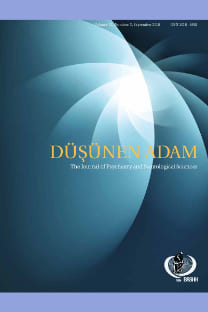Electroconvulsive therapy in the adolescent group case report
Ergen grupta elektrokonvulsif tedavi kullanımı olgu sunumu
___
Singh A, Kar SK. How Electroconvulsive therapy works?: Understanding the neurobiological mechanisms. Clin Psychopharmacol Neurosci 2017; 15:210-221. [CrossRef]Grover S, Malhotra S, Varma S, Chakrabarti S, Avasthi A, Mattoo SK. Electroconvulsive therapy in adolescents: a retrospective study from north India. J ECT 2013; 29:122-126. [CrossRef]
Bloch Y, Levcovitch Y, Bloch AM, Mendlovic S, Ratzoni G. Electroconvulsive therapy in adolescents: Similarities to and differences from adults. J Am Acad Child Adolesc Psychiatry 2001; 40:1332-1336. [CrossRef]
Saatcioglu O, Tomruk NB. Practice of electroconvulsive therapy at the research and training hospital in Turkey. Soc Psychiatry Psychiatr Epidemiol 2008; 43:673-677. [CrossRef]
Lima NN, Nascimento VB, Peixoto JA, Moreira MM, Neto ML, Almeida JC, Vasconcelos CA, Teixeira SA, Júnior JG, Junior FT, Guimarães DD, Brasil AQ, Cartaxo JS, Akerman M, Reis AO. Electroconvulsive therapy use in adolescents: a systematic review. Ann Gen Psychiatry 2013; 12:17. [CrossRef]
Rey JM, Walter G. Half a century of ECT use in young people. Am J Psychiatry 1997; 154:595-602. [CrossRef]
Ghaziuddin N, Kutcher SP, Knapp P, Bernet W, Arnold V, Beitchman J, Benson RS, Bukstein O, Kinlan J, McClellan J, Rue D, Shaw JA, Stock S, Kroeger Ptakowski K; Work Group on Quality Issues; AACAP. Practice parameter for use of electroconvulsive therapy with adolescents. J Am Acad Child Adolesc Psychiatry 2004; 43:1521-1539. [CrossRef]
Friedman RA, Leon AC. Expanding the black box - depression, antidepressants, and the risk of suicide. N Engl J Med 2007; 356:2343-2346. [CrossRef]
Newman TB. A black-box warning for antidepressants in children? N Engl J Med 2004; 351:1595-1598. [CrossRef]
Lambert M, Conus P, Eide P, Mass R, Karow A, Moritz, S, Golks D, Naber D. Impact of present and past antipsychotic side effects on attitude toward typical antipsychotic treatment and adherence. Eur Psychiatry 2004; 19:415-422. [CrossRef]
- ISSN: 1018-8681
- Yayın Aralığı: 4
- Başlangıç: 1984
- Yayıncı: Kare Yayıncılık
Examining the Effects of Audiovisual Associations on Motion Perception through Task-based fMRI
Kronik normal basınçlı hidrosefali sürecinde gelişen obsesif kompulsif belirtiler: Bir olgu sunumu
Electroconvulsive therapy in the adolescent group case report
Arif ÖNDER, Aslı Sürer ADANIR, Yakup DOĞAN, Öznur BİLAÇ, Canem KAVURMA
Melek SUNDE YİLDİRİM, Guzin M SEVİNCER, ALİ KANDEĞER, Ceyda AFACAN
Ergen grupta elektrokonvulsif tedavi kullanımı olgu sunumu
Arif ONDER, Canem KAVURMA, Oznur BİLAC, Asli Surer ADANİR, Yakup DOGAN
Mirtazapine-related manic / hypomanic shift: mini review and case report
MUSTAFA DİNÇER, AHMET GÜL, Şahin BODUR, Hesna GÜL, Mehmet Ayhan CONGOLOGLU, Yasemin TAS TORUN, Mehmet Sinan AYDİN, Kamil Nahit ÖZMENLER
Mirtazapin ilişkili manik / hipomanik kayma: Mini derleme ve olgu sunumu
Mustafa DİNCER, Ahmet GUL, Sahin BODUR, Kamil Nahit OZMENLER, Yasemin TAS TORUN, Mehmet Sinan AYDİN, Mehmet Ayhan CONGOLOGLU, Hesna GUL
Mehmet Hamdi ÖRÜM, Oguzhan Bekir EGİLMEZ
Zolpidemin neden olduğu uyku ilişkili yeme bozukluğu: Olgu bildirimi ve literatür derlemesi
Carmen Maura CARRİLLO DE ALBORNOZ, Margarita GUERRERO-JİMENEZ, Luis GUTİERREZ-ROJAS
Hüseyin AKTAŞ, Hakan OGUTLU, İbrahim Selçuk ESİN, ONUR BURAK DURSUN
